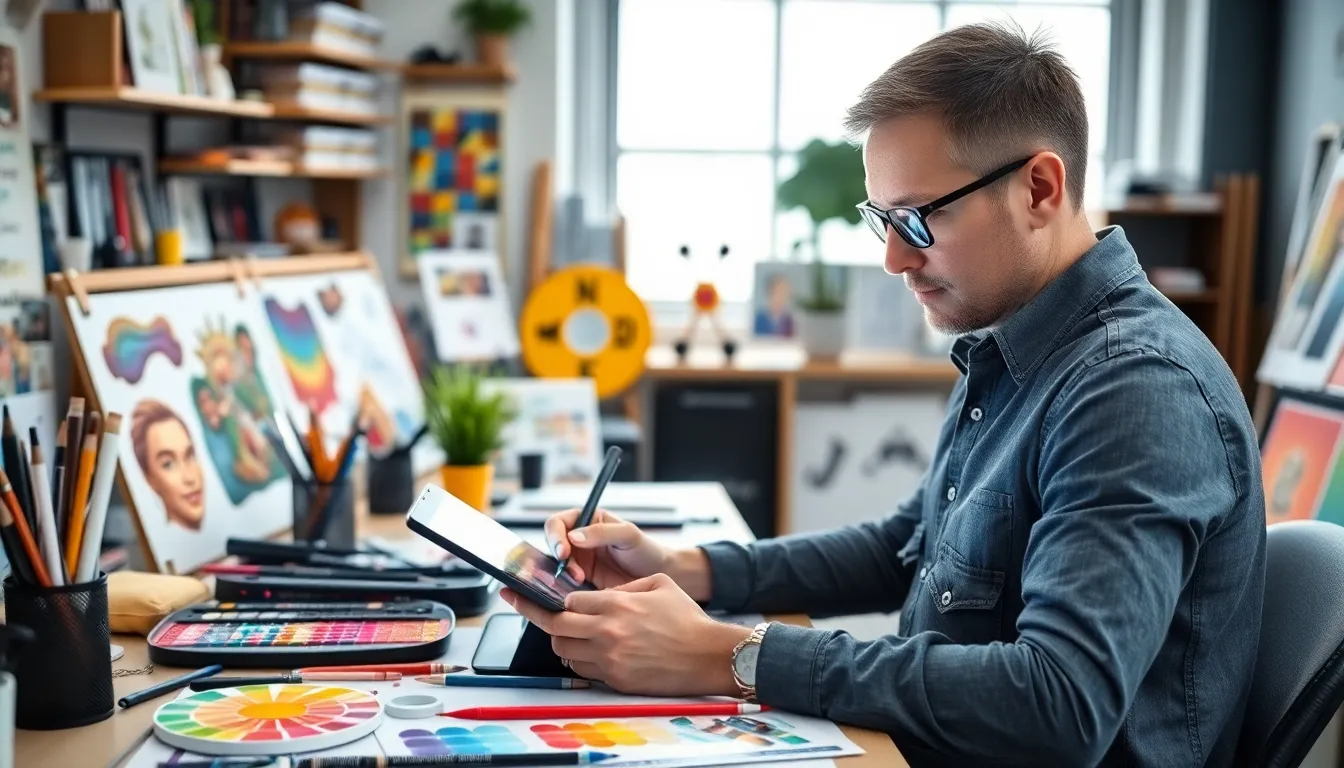Table of Contents
ToggleIn a world where visual communication reigns supreme, graphic design apps have become essential tools for creators and businesses alike. Whether it’s crafting stunning social media posts or designing eye-catching marketing materials, these apps empower users to unleash their creativity with ease.
With a plethora of options available, choosing the right graphic design app can be overwhelming. Each app offers unique features tailored to different skill levels and project needs. From beginners looking to dabble in design to seasoned professionals seeking advanced capabilities, there’s something for everyone.
This article explores the top graphic design apps that can elevate any project, making design accessible and enjoyable for all. Dive in to discover the perfect app that fits your creative vision.
Overview of Graphic Design Apps
Graphic design apps provide essential tools for creators and businesses to craft visually appealing content. These apps enable users to engage their audiences through compelling visuals. A range of graphic design apps caters to various skill levels and design needs, offering functionalities from basic editing to advanced graphic creation.
Types of Graphic Design Apps
- Vector Design Apps
Vector design apps focus on creating scalable graphics. Examples include Adobe Illustrator and CorelDRAW. These tools allow for precise, editable designs.
- Raster Graphics Apps
Raster graphics apps deal with pixel-based images. Examples include Adobe Photoshop and GIMP. These applications excel in photo editing and digital painting.
- Layout and Publishing Apps
Layout and publishing apps help in assembling complex designs. Examples include Adobe InDesign and Canva. These tools target print and digital publication needs.
- 3D Design Apps
3D design apps facilitate the creation of three-dimensional models. Examples include Blender and SketchUp. These applications are often used in industries like gaming and architecture. Mobile Graphic Design Apps
Mobile graphic design apps allow design work on-the-go. Examples include Procreate and Adobe Spark. These apps cater to users who require convenience and flexibility.
Key Features
- User-Friendly Interfaces
User-friendly interfaces simplify the design process. Intuitive layouts assist beginners while providing advanced tools for experienced designers.
- Collaboration Tools
Collaboration tools enable teams to work together seamlessly. Features like shared workspaces and feedback systems enhance productivity.
- Templates and Assets
Pre-designed templates and assets streamline the design process. Users can customize these elements to match their unique vision.
- Export Options
Diverse export options facilitate seamless use across platforms. Users can easily save designs in various formats for print, web, or social media.
Popular Graphic Design Apps
| App Name | Primary Function | Target Users |
|---|---|---|
| Adobe Illustrator | Vector Graphic Design | Professionals |
| Canva | User-Friendly Design | Beginners, Marketers |
| Adobe Photoshop | Photo Editing | Photographers, Artists |
| GIMP | Open-Source Editing | Cost-Conscious Users |
| Procreate | Digital Illustration | Digital Artists |
Graphic design apps continue to evolve, adapting to the needs of creators in various fields. These tools empower users to produce high-quality graphics efficiently, ensuring that engaging visual content remains within reach for everyone.
Top Graphic Design Apps in 2023

Several graphic design apps stand out in 2023, each offering unique features that cater to different needs and preferences. Below, discover three prominent options that can significantly enhance design projects.
App 1: Adobe Illustrator
Adobe Illustrator serves as a leading vector graphic design tool, offering robust features for creating detailed illustrations and graphics.
- Precision and Scalability: It supports infinite scalability of designs without loss of quality, essential for creating logos and detailed artwork.
- Advanced Tools: Users benefit from features like the Pen tool, which allows for intricate designs, and the Shape Builder tool, which simplifies complex shapes.
- Integration: Seamless integration with other Adobe Creative Cloud apps streamlines workflows for users who utilize multiple Adobe products.
- Collaboration: It offers collaborative options, making it easier for teams to share and edit projects in real-time.
App 2: Canva
Canva appeals widely to non-designers and professionals alike, simplifying the design process with its intuitive interface.
- User-Friendly Interface: Users can access a drag-and-drop platform, making it simple to create visually appealing designs quickly.
- Templates and Assets: With thousands of pre-designed templates and assets available, users can save time while producing high-quality graphics.
- Collaboration Features: It includes features that allow multiple users to edit designs, enhancing team collaboration on projects.
- Export Options: Users can export designs in various formats, including PNG, JPG, and PDF, suitable for both print and digital use.
App 3: Procreate
Procreate stands out as a versatile mobile graphic design app tailored for artists and illustrators.
- Touch-Screen Functionality: Its responsive touch-screen interface allows for seamless drawing and design using an iPad or Apple Pencil.
- Vast Brush Library: Users enjoy a diverse selection of brushes, enabling the creation of unique textures and styles effortlessly.
- Animation Features: Procreate includes tools for basic animation, allowing users to create moving graphics, a rare feature in mobile apps.
- Affordable Pricing: With a one-time purchase cost, it provides an economical alternative to subscription-based graphic design software.
These apps highlight the diverse capabilities available in graphic design, ensuring users can find tools that fit their specific project requirements and enhance their creative output.
Key Features to Look for in Graphic Design Apps
Selecting the right graphic design app requires understanding key features that enhance usability and productivity. Below are essential attributes to consider.
User-Friendly Interface
User-friendly interfaces simplify the design process. Intuitive layouts allow users to navigate tools effortlessly, reducing the learning curve for beginners. Essential controls, like drag-and-drop functionality and clearly labeled icons, enable users to access features quickly, facilitating a smoother workflow. Examples include Canva and Procreate, which prioritize ease of use in their design environments.
Collaboration Tools
Collaboration tools enhance teamwork in graphic design apps. Real-time sharing and editing features enable multiple users to work simultaneously on projects. Commenting options allow for direct feedback on designs, streamlining the revision process. Apps like Adobe Creative Cloud and Figma excel in offering robust collaboration capabilities, making them ideal for teams working on joint projects.
Template Library
Template libraries provide pre-designed layouts that accelerate project completion. A diverse selection of templates caters to various design needs, from social media graphics to presentations. High-quality templates spark creativity and serve as a foundation for custom designs. Apps like Adobe Spark and Canva feature comprehensive template collections, allowing users to produce professional-grade graphics efficiently.
Pricing Models for Graphic Design Apps
Graphic design apps come with various pricing models, allowing users to select options that best fit their budgets and needs. This section examines the distinctions between free versus paid options and subscription plans.
Free vs. Paid Options
Free graphic design apps typically provide essential tools and features suitable for beginners and casual users. Options like Canva and GIMP offer limited functionalities but sufficient for basic design tasks. Users may encounter ads or watermarked outputs with free versions. In contrast, paid apps, such as Adobe Illustrator and Adobe Photoshop, deliver advanced capabilities, extensive libraries, and enhanced support. These tools benefit professionals pursuing high-quality, detailed designs and include ongoing updates and premium resources.
Subscription Plans
Subscription plans for graphic design apps vary in structure and offerings. Monthly or annual subscriptions provide access to entire software suites or standalone applications. Adobe Creative Cloud operates on a subscription model, offering access to its full range of apps for a monthly fee, generally around $52.99 per month. Canva offers a Pro plan at $12.99 per month, featuring additional templates and collaboration tools. Long-term commitments may result in discounts, enabling budgeting for users who require these tools regularly. Students and educators often receive special pricing, contributing to broader accessibility for those in educational settings.
Graphic design apps are revolutionizing the way creators and businesses approach visual content. With a diverse array of tools available, users can find the perfect fit for their skill level and project needs. Whether it’s a powerful desktop application or a convenient mobile app, these tools empower individuals to bring their ideas to life.
As technology continues to evolve, the accessibility and functionality of graphic design apps will only improve. This ensures that anyone can harness their creativity and produce stunning visuals. Embracing these apps can lead to engaging designs that resonate with audiences and elevate any project.





